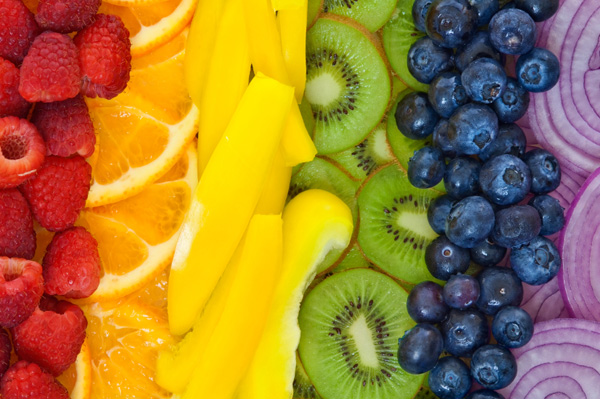
According to the Produce for
Better Health, PBH, it is no longer enough to eat your "greens."
Nutrition and health researchers are learning that eating your blues,
reds, yellows, oranges, purples, and even whites are also important for
your health. An easy and fun way to remember to eat your fruits and
vegetables is by thinking of eating the different colors of the rainbow.
This ensures giving your body a wide range of valuable nutrients like
fiber, folate, potassium, and vitamins A and C. In addition to these
nutrients, fruits and vegetables are filled with disease-fighting
chemicals known as phytochemicals.
Phytochemicals
Phytochemicals
are healthful chemicals found in fruits and vegetables. Phytochemicals
may be referred to as antioxidants, flavonoids, isoflavones,
carotenoids, allyl sulfides, and polyphenols. Phytochemicals are
responsible for giving fruits and vegetables their color. According to
the Center for Disease Control and Prevention, CDC, research has shown
that eating these powerful nutrients may strengthen the immune system
and decrease the risk of certain cancers, type II diabetes, stroke, high
blood pressure, and cardiovascular disease. Phytochemicals often work
together, so it is important to choose fruits and vegetables from all
the color groups.
Red Fruit and Vegetables
Examples
of red fruits and vegetables are red grapes, pomegranates, raspberries,
strawberries, watermelon, pink or red grapefruit, tomatoes, beets,
radishes, red peppers, rhubarb, cherries, cranberries and red apples.
Lycopen and anthocyanins are both powerful antioxidants that give the
red group their color. These phytochemicals are thought to reduce the
risk of certain cancers, especially prostate cancer. They are also
linked to heart health and prevention of lung disease. Lycopene and
anthocyanins also help to maintain memory function and urinary tract
health and fight off infections as well.
Green Fruits and Vegetables
Green
fruits and vegetables include foods such as kiwi fruit, honeydew melon,
avocado, broccoli, spinach, artichoke, zucchini, lettuce, celery,
asparagus, edamame, okra, kale, turnip greens and peas. Phytochemicals
found in green foods include lutein, zeaxanthin and indoles and are
thought to help prevent cataracts and age-related macular degeneration.
They also assist to speed up the action of enzymes that break down
carcinogens as well as strengthen bones and teeth.
Orange and Yellow Fruits and Vegetables
This
color category contains fruits and vegetables such as sweet potatoes,
cantaloupe, grapefruit, mango, yellow peppers, corn, pineapple, carrots,
butternut squash, peaches, pumpkin, apricots, tangerines and oranges.
Phytochemicals found in this group include carotenoids and
bioflavonoids, which help maintain the immune system, slow aging,
prevent heart disease, protect against cancer and improve vision health.
White and Tan Fruits and Vegetables
This
is often the forgotten color group, yet whites are important, too.
Examples from this group are bananas, mushrooms, onions, parsnips,
potatoes, cauliflower, garlic, jicama, ginger and turnips.
Anthoxanthins, which are in the white/tan group, may help lower
cholesterol, lower blood pressure, and prevent heart disease. Allicin,
which has been found to have anti-tumor effects and may especially
decrease risk of stomach cancer, is also found in this group.
Purple and Blue Fruits and Vegetables
This
group includes foods such as purple cabbage, blueberries, blackberries,
black grapes, raisins, eggplant, plums, prunes and figs. Anthocyanins,
phenolics, resveratrol may reduce the risk of cancer, stroke and heart
disease, as well as improve memory and promote healthy aging.


















 The
parsley health benefits are both impressive and undeniable. Parsley has
been proven to slow tumor growth, strengthen the heart and relieve a
wide variety of health problems. The benefits of parsley are so great
that this ancient herb is still used in medicine today.
The
parsley health benefits are both impressive and undeniable. Parsley has
been proven to slow tumor growth, strengthen the heart and relieve a
wide variety of health problems. The benefits of parsley are so great
that this ancient herb is still used in medicine today.



